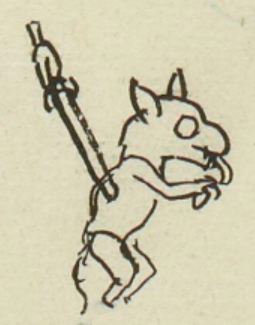Coyotlami (MH532r)
This black-line drawing of the compound glyph for the personal name Coyotlami (“The Coyote Perishes,” attested here as a man’s name) shows an entire body of a coyote, standing on its hind legs, in profile, facing toward the right. Its tongue is protruding and its front paws are up near its mouth. Its visible eye appears open. To indicate its is dying, the artist has pierced the side of the coyote's abdomen with an arrow (at an angle). The arrow has the usual wing and down feathers decorating the upper shaft.
Stephanie Wood
This name can serve as a complete sentence. Unlike many sentences in the collection, the implied verb "to be" is not required, as the verb tlami (to perish) is provided in the gloss.
The decoration on the arrow or dart is similar whether it is an acatl, a mitl, or a tlacochin. The tlaxichtli is an arrow used with the crossbow that is primarily shown in a way that emphasizes its barbed point, but at least one tlaxichtli from the Matrícula de Huexotzinco shows the same feathered decorations. See below.
Stephanie Wood
luis coyotlami
Luis Coyotlami
Stephanie Wood
1560
Jeff Haskett-Wood
coyotes, arrows, flechas, muerte, death, feathers, plumas

coyo(tl), coyote, https://nahuatl.wired-humanities.org/content/coyotl
tlami, end, finish, perish, die, https://nahuatl.wired-humanities.org/content/tlami
El Coyote Fallece
Stephanie Wood
Matrícula de Huexotzinco, folio 532r, https://www.loc.gov/resource/gdcwdl.wdl_15282/?sp=143&st=image
This manuscript is hosted by the Library of Congress and the World Digital Library; used here with the Creative Commons, “Attribution-NonCommercial-ShareAlike 3.0 License” (CC-BY-NC-SAq 3.0).





